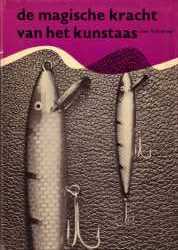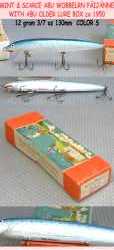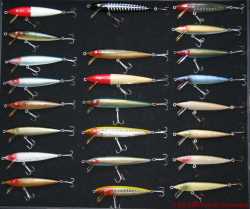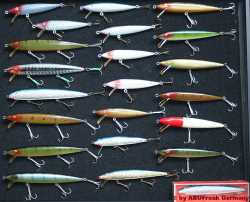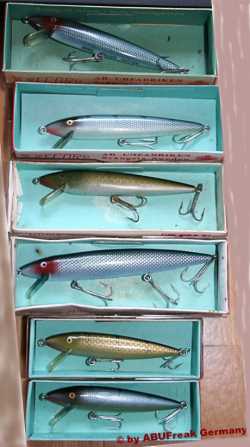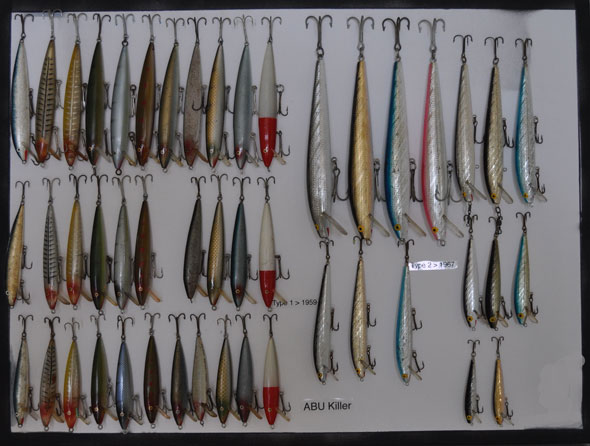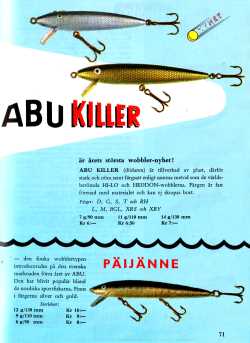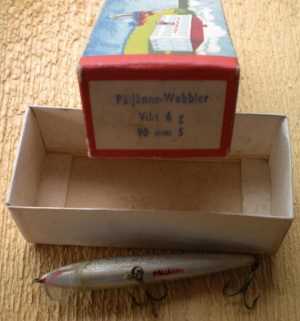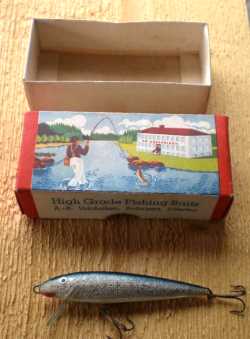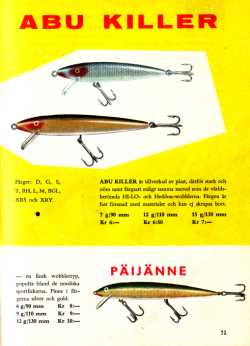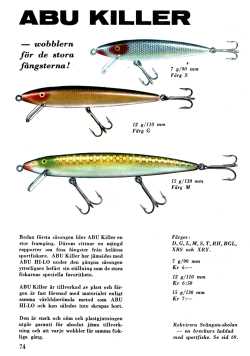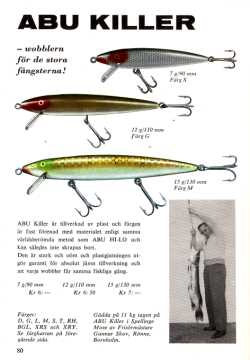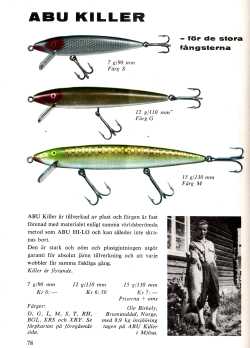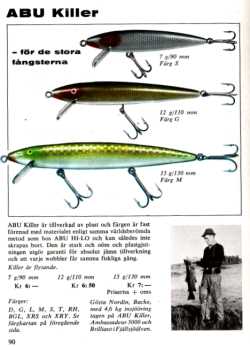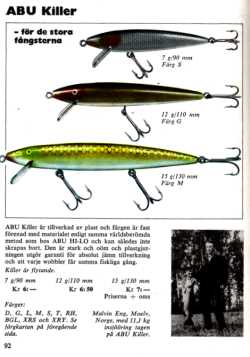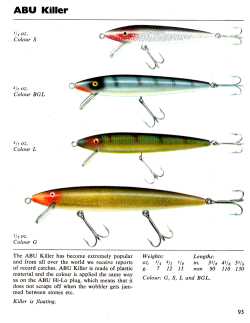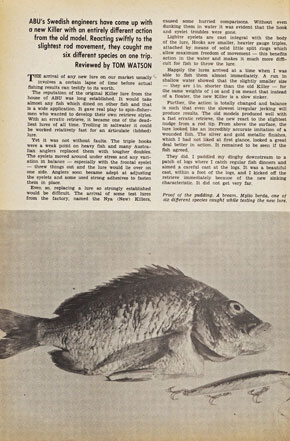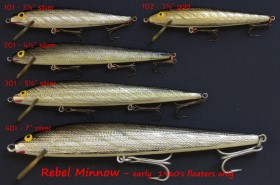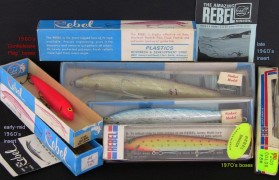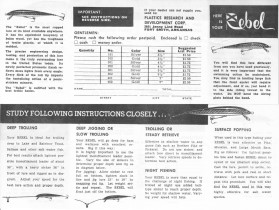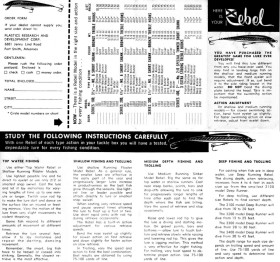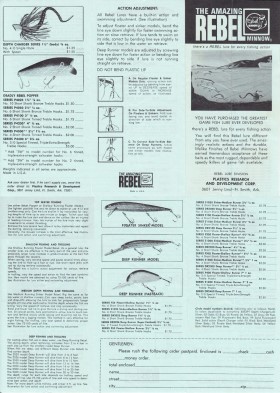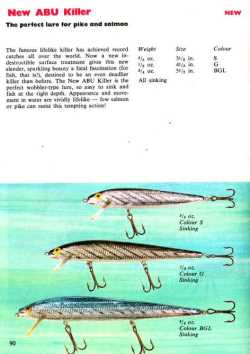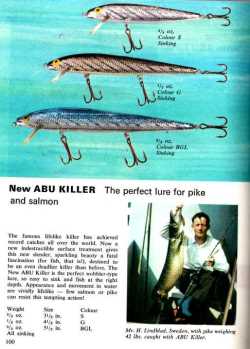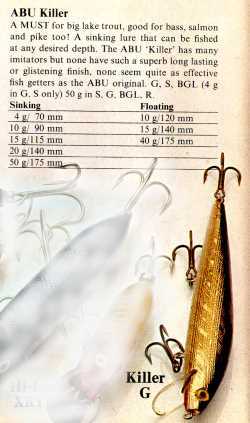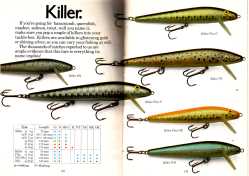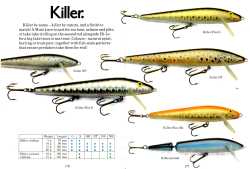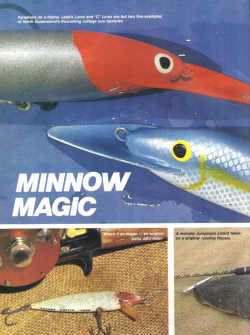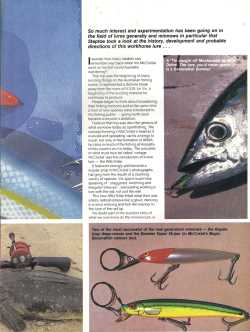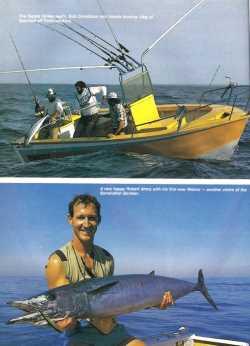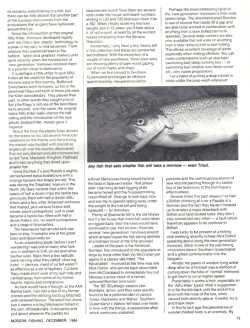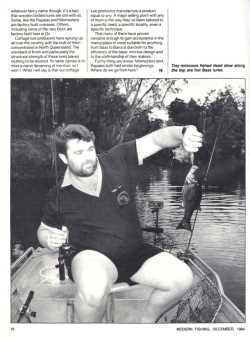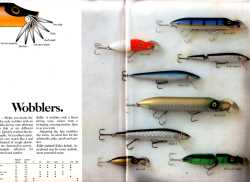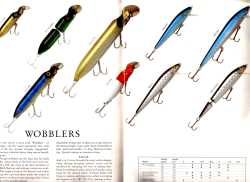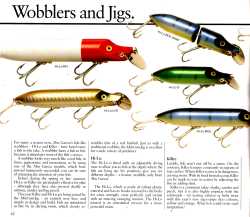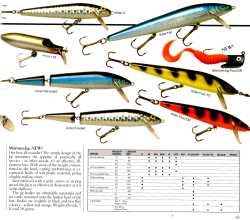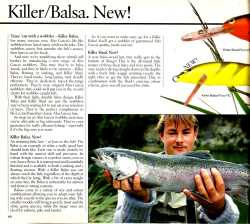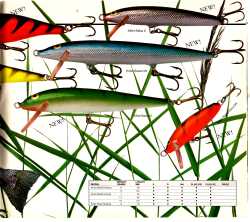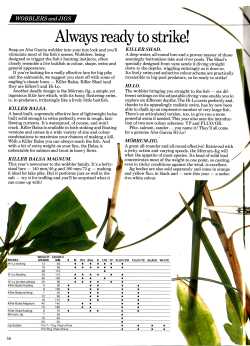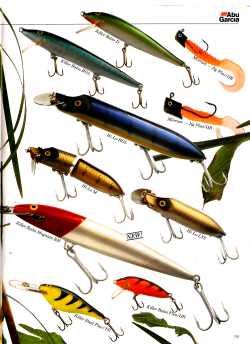Lures/Baits/Artificials
Killer Study  Killer
Study
Killer
Study
A work in progress which all will appreciate I'm sure!
Thanks to Derrik, Hans, Henrik and Uffe and others yet to contribute.
Please feel welcome to contribute and improve this article.
1959 to the Present!
ABU Killer
As I began the Toby history and Hi-Lo history, what better way to start off the history of the famous ABU Killer lure than to quote directly from the ABU authority himself.
You wanted some more info about the Killer lure.
The original Rapala lure was getting very popular. It was made of wood bark and did not hold up very well if attacked by a big pike.
A company in the
The Rebel lure had better and more consistent movement in the water and was not damaged by the sharp pike teeth.
Instead of making just another copy of the Rapala we decided to buy the plastic bodies from the Rebel Company.
They were then assembled and packaged in
After I left ABU, this lure as well as all the other lures were
made in the Orient. I however do not think that the quality
suffered. It just made the lures less costly.
Kind Regards!
Len
General Observations
For
those interested in the history of the Finnish minnow in general
My first experience with the ABU Killer was in 1967 when I was a teenager getting meager amounts of pocket money to spend on fishing lures which were very expensive in reference to my world. It was interesting that when i saw the Rebel Killers from USA it was several years after I had bought the Swedish licenced bodies and sold under the ABU brand name.
All Swedish made ABU Killers had either 2 or 3 treble hooks depending on size (length and weight)
All Swedish made ABU Killers were made of plastic (until a Balsa version was sold in 1988) unlike the growing range of Finnish Baltic pine minnows such as the Paijanne below which was initially available in silver and gold. Sizes were 10g 130mm, 9g 110mm and 6g 90mm only. I suspect but cannot confirm that they were floating models only.
As a prelude to the ABU Killer, the Paijanne from Finland was included in the two ABU Catalogs of 1958 and simultaneously with the official Swedish ABU Killer in 1959. It looked remarkably similar to a whole line of Finnish minnows which ended up evolving in the great names of ABU and Rapala. I believe Baltic pine was used in the other minnows, through which which colour was impregnated, until the spray on colour was used on the new plastic ABU Killers released in 1967.

Hans from The Netherlands adds "Päijänne actually is a sizable lake in Finland, the one where Lauri Rapala tested his first plugs in the mid-1930’s. On the southern edge of the lake lies the town of Vääksy where the Finnish Rapala works are still situated. Probably they made the Päijänne lure for ABU, which is very similar to their own original Rapala plug. I would bet they did, but this is not absolutely certain, because there were more lure makers in the Päijänne area, such as Finlandia Uistin, better known as the makers of Nils Master lures."
Only confusing point is that I have seen for sale in an ABU Paijanne paperbox an example (marked on belly) which was never advertized in the catalogs. It is blue and silver as well as being 12g and 130 mm long. Certainly different to first catalogue offerings in 1958 and 1959.
Derrik Figge (ABUFreak) has kindly shared some requested rarely seen images from his massive early Killer collection here.
My personal ABU Killer collection to date. I needed the 1st model 12g Gold for a long time . Now the collection for standard production models is complete.
HISTORY (as documented via catalog advertizing)
1959 The first year that the ABU Killer appeared, all 10 colours were available.
The Paijanne was imported from Finland. I was available in 3 sizes and 3 colours
1960 No changes for the second year of production.
1961 The Paijanne is removed from ABU catalog due to the availability and success of 30 different ABU Killers!
1962 The only changes to ABU Killer advertizing for the next four years is the addition of more meritorious catches attributed to the lure.
1963
1964
1965
1966 ABU Killer is now advertized as being made
of plastic with colour penetrating completely through the material.
Colour does not scrape off.
Some believe it was not made this way in the beginning 7 years
earlier. I personally see no reason to believe this line of thought,
without ABU stating a change was made in construction and a
reason outlined. I would like definitive document proof of this fact.
1967 This is the first big change to ABU Killer line-up and it is when I came into using ABU Killers, the beautiful silver, combined and black , gold and blue cross-hatched scale pattern.
Len (at the top of this page) explains the USA origin of this form of the Killer and was so impressed with the performance of the lures that he bought the whole company.
Here we see an Australian Outdoors Magazine Consumer Report on the new ABU Killer from 1967
Rebel package inserts detail ...
First Rebel Minnows in 1962 were floaters only in 4 sizes from 3.5
to 7 inches and 2 colors, silver or gold. Model numbers were 3
digits, e.g. 301. Lips were not embossed and bellies were
unmarked. The clear lacquer coat on silver models is often so
yellowed, it looks like underpainted gold.
Within
a few years, sinkers, smaller size, and many more colors were added
(along with big diving lip and Fastback shape models not relevant to
ABU). Sinker model numbers were at first four digits, e.g.
1301. Slightly later, S and F were included. So, the
sinker became S1301 and the floater F301. Saltwater grade was
S1301SW. At this time, bellies were stamped FLOATER or
SINKER. Many, not all, lips were embossed, but only “EBEL”
shows externally.
In
the 1970’s, lips were elaborately embossed, e.g. REBEL Made in
U.S.A. FLOATER. Bellies are no longer stamped. Finishes
like Rainbow Trout, Brown Trout, Mackerel.
Interesting
that ABU wanted sinkers first. Also, that ABU didn’t take the
7” until later either.
Thanks to John Fishkat for Rebel images here.
Incidentally my $ 2 per fortnight pocket money bought me just one of these beauties that i used to chase barramundi with. I learned to cast carefully and swim for snagged lures due to the then high cost for a teenager.
1968 No changes except to line-up at all, except to pictorially reference meritorious catches to the Killer.
1969 These released in three colours BGL, G and B for all four sizes of 1/8 oz, 3/8 oz, 1/2 oz and 3/4 oz
1972 It was not until this year that that the BGL colour was dropped from the smallest Killer (1/8 oz)
No more changes for 2 years.
1974 The 40g large Killer was released
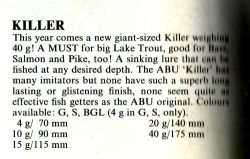
1976 Most significant change introduced was the new floating versions in 10g, 15g and 40g and sinking version in 50g size.
ABU start to advertize their Killers along side their other plugs for the first time. So we see Hi-Lo Kynoch, Snoky, Cello and killer alongside on the same pages.
1981
1981 sees ABU-Garcia take its lure production offshore and to the far east.
Questions on this matter produced these very helpful responses from different PF Managers in Sweden and France.
Hi Wayne,
The manufacturing of all lures was moved to the Far East in
1981.
Best regards,
Anita Enarsson
--
Abu AB
SE-376 81 Svängsta
SWEDEN
Hi Wayne
We
do not make any lure in
Hope it helps. Any question I remain.
Regards
Sylvain
Manager PF (European Division) France.
I guess as ABU went off shore to Asia for production, new changes were inevitable.
To me the soul of the Killer and other ABU lures, I used in my youth departed when production left Sweden.
First change in the ABU Killer line-up for many years. I guess , if it ain't broke, don't fix it!
I guess as ABU went off shore to Asia for production, new changes were inevitable.
To me the soul of the Killer and other ABU lures, I used in my youth departed when production left Sweden.
On the positive side and for fishing effectiveness we now see some all new sinking Killers with Natural colours as well as the use of the new technology Mylar tape coverings which enhance reflectiveness.
1982
1983 Same line-up of sizes and colours except the jointed (ledad) version is shown in the catalogue.
1984 No changes this year
The passage of 3 decades production never allows the ABU Killer to be forgotten for its long term fish catching qualities, even if more modern authors from Modern Fishing 1984, do manage to get some things wrong like what it was made from. ABU Killers were always made of plastic in the 50's to mid 80's, NOT Balsa wood!
1985
Killers no longer considered worthy of a page of their own in catalogue advertizing. The page was titled wobblers and mixed with Hi-Lo lures.
1986
1987
1988
Balsa wood used to construct the body of the lure. More colour options offered
1989
1990
Further Asian-made ABU Killer documentation not to be continued .....
If you have any other ABU Killer lures, particularly in the early plastic finish, that are mint or boxed, and are un-needed or doubles in your collection and are available for swapping or a reasonable fee, I would be very pleased to hear from you.
